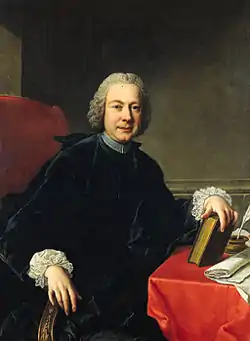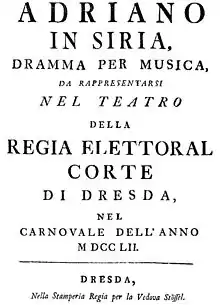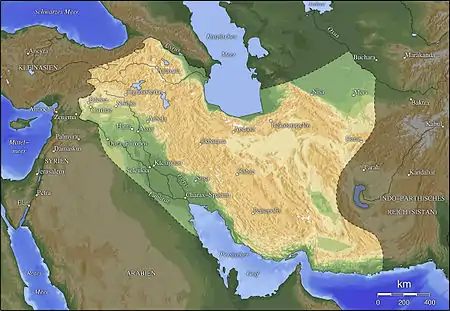Adriano in Siria
Adriano in Siria (Hadrian in Syria) is a libretto by Italian poet Metastasio first performed, with music by Antonio Caldara, in Vienna in 1732, and turned into an opera by at least 60 other composers during the next century.[1][2] Metastasio based the background of the story on late Classical works by Cassius Dio (Book 19 of the Roman History) and Elio Sparziano (Vita Hadriani Caesaris).[3]


The aria Che fa il mio bene? also known as L'amante impaziente, sung by the character Emirena, was set to music by Ludwig van Beethoven in his Opus 82: 4 Arietten und ein Duett.[3]
Performances

The libretto was composed for Charles VI, Holy Roman Emperor and premiered in the Theater am Kärntnertor in Vienna on 4 November 1732.[4] The scenes were designed by Antonio Galli da Bibiena (1697–1774). A revised version was first performed in 1733, with music by Giacomelli.[5]
Some of the later operas based on this libretto were also created for royal festivities: the version by Pergolesi was intended for the birthday of Elisabeth Farnese, the Queen of Spain, and premiered at the Teatro San Bartolomeo in Naples on 25 October 1734, with the castrato Caffarelli singing the part of Farnaspe, which was radically altered from the first version of just two years earlier. In the yet again altered version of 1735 by Francesco Maria Veracini, written for the short-lived but ambitious Opera of the Nobility in London, the same role was sung by Farinelli, joined in an all-star cast by Senesino, Francesca Cuzzoni and Antonio Montagnana (Burden 2007, 31). George Frederic Handel was present at the premiere in Haymarket Theatre. Charles Jennens liked the opera and ordered a score; Lord Hervey, not known for his musical perception, and Henry Liddell, 1st Baron Ravensworth were bored (Dean 2006, 278–79; Van Til 2007, 121). However, the work enjoyed a run of twenty performances over six months (Helyard 2000).
In 1768–69, Ignaz Holzbauer also composed an opera based on the libretto by Metastasio, this time to be performed at the royal wedding between Amalie of Zweibrücken-Birkenfeld and Frederick Augustus I of Saxony on 29 January 1769. The 1765 version by Johann Christian Bach, while not especially created for a royal occasion, was even visited twice by George III of the United Kingdom and his wife Charlotte of Mecklenburg-Strelitz when it was performed in London in 1765.[4][6]
As a royalist or even imperialist opera, it was badly received by Republicans and revolutionaries. In 1792, Étienne Méhul had finished his version Adrien with a libretto by François-Benoît Hoffman based on Metastasio; it was set to premier at the Paris Opera on 6 March 1792, but the Commune opposed it, as the opera was written by an Austrian (Anti-Austrian sentiments were running high at the time and France would declare war on Austria the next month), and the theme was imperialistic, which went against the ideals of the French Revolution. The premier was postponed for a week, and Hoffman defended his work in an open letter, but to no avail, as the work was banned on 12 March 1792.[7] It finally premiered in 1799, but was again shut down by the Directory after four performances.[8]
Roles

- Adriano: governor of Syria, in love with Emirena
- Emirena: prisoner of Adriano, in love with Farnaspe
- Farnaspe: friend of Osroa and prince of the Parths, in love with and betrothed to Emirena
- Osroa: King of the Parthian Empire, father of Emirena
- Sabina: in love with and betrothed to Adriano
- Aquilio: tribune, friend of Adriano and secretly in love with Sabina
Synopsis
Set in Antioch against the historic background of the time the future Roman Emperor Hadrian spent as Governor of Syria, it tells a fictional love story, where the virtue of Adriano is tested by his infatuation with Emirena, a Parthian princess, both before and after his marriage to Sabina. One of the subplots in the story is the attempt by Osroa to kill Adriano in a fire. Eventually, all ends well, Osroa is spared, Farnaspe marries Emirena, and Adriano returns to the love of his wife Sabina.[6]
Operas based on the Metastasio libretto
- 1732: Antonio Caldara[3][9]
- 1733: Geminiano Giacomelli[5][10]
- 1734: Giovanni Battista Pergolesi, Adriano in Siria[3][4][11]
- 1734: Pietro Giuseppe Sandoni[5]
- 1735: Francesco Maria Veracini (adaptation of the libretto by Angelo Cori)[4][11]
- 1735: Riccardo Broschi[12]
- 1736: Egidio Duni[9][13]
- 1737: Giovanni Battista Ferrandini[9][14]
- 1737: José de Nebra, Adriano en Siria o Más gloria es triunfar de sí[15]
- 1737: Giovanni Porta[16]
- 1739: Giovanni Alberto Ristori[5][17]
- 1740: Baldassare Galuppi[5][6]
- 1740: Michele Caballone[9]
- 1740: Giovanni Battista Lampugnani[5]
- 1740: Antonio Giai[18]
- 1745: Giovanni Verocai, Die getreue Emirena Parthische Prinzeßin[19]
- 1745: Carl Heinrich Graun, Artabanus[9][19]
- 1746: Girolamo Abos[9]
- 1746: Paolo Scalabrini[20]
- 1747: Gaetano Latilla[21]
- 1747-48: Vincenzo Legrenzio Ciampi[9][18][22]
- 1750: Ignazio Fiorillo[19]
- 1750: Giovan Battista Pescetti[3]
- 1750: Antonio Gaetano Pampani[23][24]
- 1751: Andrea Adolfati[9][25]
- 1752: Giuseppe Scarlatti[9][18]
- 1752: Johann Adolph Hasse[9][19]
- 1752: Davide Perez[9][26]
- 1753: Michelangelo Valentini[27]
- 1753: Giuseppe Scolari[28]
- 1754: Nicola Conforto[29]
- 1755: Andrea Bernasconi[9][30][31]
- 1756: Rinaldo di Capua[32]
- 1757: Francesco Uttini[33]
- 1757: Francesco Brusa[3][18]
- 1758: Giovanni Battista Borghi[34]
- 1758: Baldassare Galuppi (second version)[9][18]
- 1760: Antonio Maria Mazzoni[18]
- 1762: Johann Gottfried Schwanenberger[9]
- 1762: Giuseppe Colla[35]
- 1763: Gregorio Sciroli[36]
- 1764: Marian Wimmer[37]
- 1765: Pietro Alessandro Guglielmi[9][38]
- 1765: Johann Christian Bach[3][4][9]
- 1768: Ignaz Holzbauer[4][9][39]
- 1768: Hieronymus Mango[40]
- 1769: Gian Francesco de Majo[9][41]
- 1769: Carlo Monza[42][43]
- 1770: Antonio Sacchini[3][9]
- 1770: Antonio Tozzi[44]
- 1773: Giacomo Insanguine[32]
- 1775: Gaetano Monti[45]
- 1776: Josef Mysliveček, Adriano in Siria[9]
- 1777: Pasquale Anfossi[46]
- 1778: Giuseppe Sarti[3]
- 1779: Felice Alessandri[47]
- 1781: Giacomo Rust[48]
- 1782: Luigi Cherubini[3][9]
- 1788: Jakob Friedrich Gauss, Hadrian in Syrien[49]
- 1789: Sebastiano Nasolini[9]
- 1798: Simon Mayr[9][50]
- 1799: Étienne Méhul, Adrien, libretto by François-Benoît Hoffman adapted from Metastasio[51]
- 1807: Joseph Weigl, Kaiser Hadrian[52]
- 1811: Vincento Migliorucci[9]
- 1813: Marcos Portugal[9][53]
- 1815: Giuseppe Farinelli[3][9]
- 1821: Pietro Airoldi[9]
- 1828: Saverio Mercadante[3]
References
- Pajares Alonso, Roberto L. (2010). Historia de la música en 6 bloques, Volume 2 (in Spanish). Visión Libros. p. 152. ISBN 9788499833439.
- Kennedy, Michael (2003). Words on Music: Essays in Honor of Andrew Porter. Pendragon. p. 182. ISBN 9781576470916.
- Metastasio, Pietro (3 January 2011). "Adriano in Siria". In Lavezzi, Gianfranca (ed.). Melodrammi e arie. Bur. ISBN 9788858614198.
- Feldman, Martha (2010). Opera and Sovereignty: Transforming Myths in Eighteenth-Century Italy. University of Chicago. p. 258. ISBN 9780226044545.
- Holmes, William (1994). Opera Observed: Views of a Florentine Impresario in the Early Eighteenth Century. University of Chicago. ISBN 9780226349718.
- Bagnoli, Giorgio (1993). The La Scala Encyclopedia of the Opera. Simon and Schuster. p. 10. ISBN 9780671870423.
- Darlow, Mark (2012). "Censorship at the Opéra: the controversy over Adrien". Staging the French Revolution: Cultural Politics and the Paris Opera, 1789–1794. Oxford University. ISBN 9780199773725.
- Abraham, Gerald (1982). The Age of Beethoven, 1790–1830. Oxford University. p. 71. ISBN 9780193163089.
- Clément, Félix; Larousse, Pierre (1869). Dictionnaire lyrique: ou, Histoire des opéras contenant l'analyse et la nomenclature de tous les opéras et opéras-comiques représentés en France et à l'étranger depuis l'origine de ce genre d'ouvrages jusqu'à nos jours (in French). Administration du Grand dictionnaire universel. p. 8.
- Adriano in Siria. Carlo Buonarrigo. 1733. p. 7.
metastasio adriano.
- Sadie, Julie Anne, ed. (1998). Companion to Baroque Music. Oxford University Press. p. 49. ISBN 9780198167044.
- barbier, Patrick (1995). Farinelli (in French). Grasset. ISBN 9782246484097.
- Franchi, Saverio. Drammaturgia romana, vol. II, (1701-1750) (in Italian). Ed. di Storia e Letteratura. p. 287. ISBN 9788863723366.
- Rudhart, Franz Michael (1865). Geschichte der Oper am Hofe zu München, Volume 1 (in German). Datterer. p. 127.
- Pajares Alonso, Roberto L. (2010). Historia de la música en 6 bloques, Volume 2 (in Spanish). Visión Libros. p. 162. ISBN 9788499833439.
- "Opening Night! Opera & Oratorio Premieres". Stanford University Libraries. Retrieved 3 November 2014.
- "SearchWorks". Stanford University Libraries. Retrieved 31 October 2014.
- Selfridge-Field, Eleanor (2007). A New Chronology of Venetian Opera and Related Genres, 1660-1760. Stanford University. p. 511. ISBN 9780804744379.
- Lütteken, Laurenz; Splitt, Gerhard, eds. (2002). Metastasio im Deutschland der Aufklärung (in German). Walter de Gruyter. p. 71. ISBN 9783110927146.
- "Opening Night! Opera & Oratorio Premieres". Stanford University Libraries. Retrieved 3 November 2014.
- "Opening Night! Opera & Oratorio Premieres". Stanford University Libraries. Retrieved 3 November 2014.
- Metastasio (1750). Adriano in Syria. Opera. London: G. Woodfall.
- Metastasio, Pietro (1750). Adriano in Siria. Milan: Giuseppe Richino Malatesta.
- "Opening Night! Opera & Oratorio Premieres". Stanford University Libraries. Retrieved 3 November 2014.
- "Opening Night! Opera & Oratorio Premieres". Stanford University Libraries. Retrieved 3 November 2014.
- "Opening Night! Opera & Oratorio Premieres". Stanford University Libraries. Retrieved 3 November 2014.
- "Opening Night! Opera & Oratorio Premieres". Stanford University Libraries. Retrieved 3 November 2014.
- Gluck, Christoph Willibald Ritter von (2007). Orfeo ed Euridice (in Italian). Pendragon. p. 37. ISBN 9788883425516.
- Metastasio (1757). Adriano in Siria. Madrid.
- Metastasio, Pietro (1755). Adriano in Siria. Monaco: Giovanni Vötter.
- "Opening Night! Opera & Oratorio Premieres". Stanford University Libraries. Retrieved 3 November 2014.
- The Quarterly Musical Magazine and Review. Baldwin, Cradock and Joy. 1823. p. 306.
riccardo broschi adriano.
- "Opening Night! Opera & Oratorio Premieres". Stanford University Libraries. Retrieved 3 November 2014.
- Howard, Patricia (2014). The Modern Castrato: Gaetano Guadagni and the Coming of a New Operatic Age. Oxford University. p. 86. ISBN 9780199365203.
- "SearchWorks". Stanford University Libraries. Retrieved 31 October 2014.
- Adriano en Siria. Barcelona: Francisco Generas. 1763. p. 14.
- "Opening Night! Opera & Oratorio Premieres". Stanford University Libraries. Retrieved 3 November 2014.
- "Opening Night! Opera & Oratorio Premieres". Stanford University Libraries. Retrieved 3 November 2014.
- Cannabich, Christian (1999). Ballet music from the Mannheim court. A-R Editions. p. ix. ISBN 9780895794192.
- "Opening Night! Opera & Oratorio Premieres". Stanford University Libraries. Retrieved 3 November 2014.
- "SearchWorks". Stanford University Libraries. Retrieved 31 October 2014.
- Metastasio, Pietro (1769). L'Adriano in Siria. Naples: Francesco Morelli.
- "SearchWorks". Stanford University Libraries. Retrieved 31 October 2014.
- "Opening Night! Opera & Oratorio Premieres". Stanford University Libraries. Retrieved 3 November 2014.
- "Opening Night! Opera & Oratorio Premieres". Stanford University Libraries. Retrieved 3 November 2014.
- "SearchWorks". Stanford University Libraries. Retrieved 31 October 2014.
- "Opening Night! Opera & Oratorio Premieres". Stanford University Libraries. Retrieved 3 November 2014.
- "Opening Night! Opera & Oratorio Premieres". Stanford University Libraries. Retrieved 3 November 2014.
- "Opening Night! Opera & Oratorio Premieres". Stanford University Libraries. Retrieved 3 November 2014.
- Pajares Alonso, Roberto L. (2010). Historia de la música en 6 bloques, Volume 2 (in Spanish). Visión Libros. p. 221. ISBN 9788499833439.
- "Opening Night! Opera & Oratorio Premieres". Stanford University Libraries. Retrieved 3 November 2014.
- "Opening Night! Opera & Oratorio Premieres". Stanford University Libraries. Retrieved 3 November 2014.
- "Opening Night! Opera & Oratorio Premieres". Stanford University Libraries. Retrieved 3 November 2014.
External links
 Media related to Adriano in Siria at Wikimedia Commons
Media related to Adriano in Siria at Wikimedia Commons